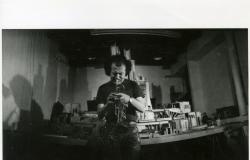Like an incisive and forceful symphony, José Ángel González Sainz offers us his latest work, So to speak (Anagrama, 2024). This is related in some features, although with a very different narrative structure and tone, to the unclassifiable The small life: the art of escape (Anagrama, 2021). Both works, in addition to being similar due to their stylistic elegance, share the need to x-ray a turbulent, noisy and neurotic world. We detect a significant crossover in the following sentence from his 2021 book with several editions to his credit: “Everything is sometimes its opposite; Happiness turns at the least expected moment towards misery”.
We are faced with an author who is fully aware of the narrative architecture that he builds with an erudite command of language, without falling into petulance or ostentation. In his humility he displays virtuous prose that can be read in different levels. There will be a reader who will be interested in the events of each story that, with the attributes of a good story, are skillfully sustained with narrative tension for pages that do not distract the reader’s attention one bit and with the power of surprise towards the end. There will also be a reader who will be carried away by the simple joy of the musical combination of words in their precise place. And there will be the reader who will seek deeper meanings of everyday events as an understanding of the human condition.
“There are four stories that the author likes to call divertimentos or pieces. Pieces that give the sensation of a parallelepiped, although their strict shape is that of a box-shaped contraption“
Such is the caliber of the literature of José Ángel González Sainz who, with a solid and extensive work, He won the Herralde Prize in 1995. We mention this recognition only because in the presentation at La Central on Mallorca Street on May 21, he placed So to speaktwo decades later, as a achievement of a record of the award-winning novel: “The challenge was to continue with the line of An exasperated worldmore crazy and at the same time pay a small tribute to Kafka on the hundred years of his death.”
In the midst of dramatic situations, the author from Soria knows how to slip in intelligent humorous details.. Already with its title, So to speak, reveals a subtle sense of humor scattered throughout pages that synergize with what is told there. There are four stories that the author likes to call divertimentos or pieces. Pieces that give the sensation of a parallelepiped, although their strict shape is that of a box-shaped contraption.
“An official, called a commisario, is in charge of calling out the numbers on the dice, always in a capricious manner, at will, because, in reality, we discover, the dice are blank.“
This is how the first part consists of two stories that are the longest with the shortest titles and the second part, on the contrary, includes two shorter stories with the longest titles. The first stories are more collective or social, to call them in a way given the setting of the plots – an open-air concert in a city and a public place to roll the dice; and the last two are more personal or existential—the intimacy of three women and a man on board a train or that of a couple obsessed with looking at the fish in their small aquarium and undergoing a metamorphosis.
Indeed, there is something Kafkaesque—or Cortazarian—about these stories, which are marked by the absurd and are not set in any specific place. We only know that it is Spain and that the characters have specific names. country. It could be said that the piece that pays the most tribute to Kafka is the second, “Casting the Dice,” in which the absurd predominates and a sharp mirror portrait of the bureaucracy of a country marked by always opposing sides. Carlos Fernández Zafra is preparing to play dice on the day that corresponds to him according to the registration. From a dizzying scene at the beginning, Fernández Zafra is abducted by a neighbor who turns him inside his car in the basement of his building to the endless line that he has to stand in to enter the premises. It is impossible to be more allegorical to the arbitrariness of today’s world: an official, called a delegate, is in charge of calling the numbers of the dice, always in a capricious way, at his whim, because, in reality, we discover, the dice are in white.
“The emotions that underlie the stories unite the portrait of an era: arbitrariness, conflict of interests, insults, lack of consideration for other people, never acknowledging the other’s reason.“
A theme connects this story with the first, “The Event,” and it is the meaning of the use of words to fabricate realities—something characteristic of authoritarian or personalist regimes with their brainwashing and ideological updates—: “Before every catastrophe there is a linguistic catastrophe,” he stated in La Central. Thus, to the extent that we approach things with words, to that same extent things move away because they become things of language.
Although it is emphasized in the first two pieces, the book ends up becoming four semiotic flashes: the symbolism of looking at the world in the same way as understanding it through words. Words that in some stories with their repetition create a poetic rhythm, Grind, grinder, grindwhich can evoke the wisdom of a father: “Fears have long legs”, the magín, the mental meanderings, the cloudy premonitions or the Filipino, Indonesian or Chinese women.
“In So to speak There are eyes in the four pieces that symbolically translate into the importance of looking at the world carefully to understand it.“
The emotions that underlie the stories unite the portrait of an era: arbitrariness, conflict of interests, insults, lack of consideration for other people, never acknowledging the right of others. In “The Event” a connecting thread between the pieces is clear: the fragility of happiness. When it seems that everything is in a state of harmony, something always happens or someone appears that comes to disturb that state of mind to the point of taking it precisely to the opposite, like an afternoon concert by the Orchestra and Choir in the Plaza Mayor of the City. in which an orchestra conductor simulator takes the baton. Events that give an implausible bias to the realm of human possibilities, often the product of a farce.
In the same way when, on board a train, in the third story, a woman disturbs a traveler while shelling pumpkin seeds and one falls in his eye. From the breakdown of the harmony of four complete strangers to a core of intimacy. And if it’s about eyes – we think of his wonderful novel Out of sight (Anagrama, 2010)—in So to speak There are eyes in the four pieces that symbolically translate into the importance of looking at the world carefully to understand it. There are people who wear glasses, nearsighted and farsighted like the man and woman in the last story who buy a fish tank and spend all day watching the fish in a calm state but, as the weeks go by, they get bored and buy a television. and they begin to ignore them with malice and sadism.
A phrase related to the colossal nihilistic and selfish shouting can summarize the spirit of the book, contained in four formidable stories, entertainments or pieces: “Everything he whistled seemed to him like a step backwards in the development of civilization.”.
—————————————
Author: JA González Sainz. Qualification: So to speak. Editorial: Anagram. Sale: All your books.
0/5
(0 Ratings. Rate this article, please)






